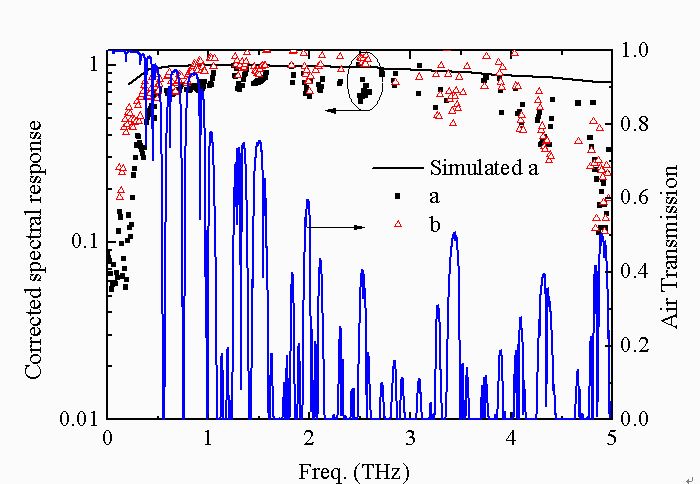
By with ZHANG Wen
Fig. 1 Corrected spectra of spiral-antenna coupled NbN HEBs, measured with Martin-Puplett interferometer as FTS and 77 K blackbody as broadband signal source. The same structure of spiral-antenna type a was simulated with Ansoft HFSS, and the calculated coupling efficiency is also plotted for comparison. Air transmission is calculated with am Atmospheric Model. The relative humidity and environment temperature are 90% and 20 degrees, respectively.
Researchers led by Prof. SHI Shengcai , Purple Mountain Observatory, Chinese Academy of Sciences, study the dispersive characteristics of broadband quasi-optical superconducting hot electron bolometers (HEB), which are based on a several nanometer thick NbN film. Spiral-antenna coupled NbN HEB mixers show a very high sensitivity in the whole terahertz frequency range of 1-6 THz, while their spectral responses measured with Fourier transform spectrometer fall quickly as frequency increases, especially above 3 THz. Directly measured spectral response of spiral-antenna coupled HEB should be governed by multi-factors, such as emission spectrum of the broadband signal source, FTS power transfer function, optical throughput, air transmission, coupling efficiency between antenna and HEB bridge, transmission of optical components (vacuum window and IR filter).
The absolute emission spectrum of Hg arc lamp used is found to be proportional to frequency in the frequency range of 0-5 THz. The deterioration of spectral response of spiral-antenna coupled NbN HEBs measured with Hg arc lamp is ascribed to its diffraction-limited optical throughput and the absolute emission spectrum of Hg arc lamp used. Using 77 K blackbody as a broadband signal source, spiral-antenna coupled superconducting NbN HEBs show a nearly flat response in the frequency range of 0.5~4 THz after correction for air absorption, confirmed by three-dimension electromagnetic field simulation. The study on spectral response of spiral-antenna coupled NbN HEBs is useful for development of high sensitive heterodyne mixers at frequencies above 3 THz.The work by ZHANG Wen , MIAO W. , LI Suliang , ZHOU Kemin , SHI S.C. (corresponding author), GAO Jingru , and Goltsman.G.N, accepted by IEEE transactions on applied superconductivity, has been published online ( http://ieeexplore.ieee.org/Xplore/defdeny.jsp?url=http%3A%2F%2Fieeexplore.ieee.org%2Fstamp%2Fstamp.jsp%3Ftp%3D%26arnumber%3D6449293%26userType%3Dinst&denyReason=-134&arnumber=6449293&productsMatched=null&userType=inst). |
